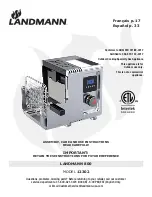
15
chance for fire. When the pan is in the proper position, no problem. The grease will flow onto the roasting
pan down to the opening, down the funnel and out underneath the grill. Just slide a bucket or metal pan
under the hole, so the grease won’t hit the ground. You will get about ½ gallon of grease from a 60lbs. pig
– the larger the pig, the more grease you get.
Also, make sure the grill is as level as you can get it.
It is
OK if the front of the grill is a tiny (and I mean tiny) bit up to help the grease flow towards the hole, but try
to keep it level.
The roasting pan is designed to create a convection movement with the heat inside the domes. Notice the
pan is beveled to catch the grease and funnel it to the opening on the one end. Also notice that there are
holes cut each side about ¾ of the length of the pan. Set the head of the pig at the end toward the front of
the grill, where there are no holes, to prevent burning.
Replace the cooking grates over the top of the roasting pan. Be careful, the cooker is on.
Prepare your meat with whatever rub you desire –
DO NOT WRAP THE COOKING GRATES IN
FOIL OR THE MEAT IN FOIL, THAT WILL TRAP THE GREASE AND CREATE A SERIOUS
FIRE POSSIBILITY
. Lay the meat across the grates.
.
Check it every ½ hour or so to make sure the grease is flowing properly, etc. Have your thermostat ready to
check temps. Also remember, you have ½ hour to 45 minutes after you take the meat off the grill to let it
“set up” before you carve it
Close dome.
You might be eager to shorten the cooking time as much as possible. (Not sure why you would want to cut
into beer-drinking time) but, BE WARNED, it is important that the meat does not roast too rapidly at the
beginning. This will result in the outside becoming hard, preventing the heat from penetrating to the
interior. So, start off slowly and gradually turn the heat up. The most difficult part of pulling off a good
slow cooked roast is getting the outside of the meat golden brown and nicely caramelized and at the same
time getting the meat inside cooked all the way through to the bone. For the majority of the cooking
duration you will want your fire to be at about 325° F (The fire is at 325° F if you can hold your hand at the
cooking level for at least 8, but no more than 12 seconds).
When is the Meat Ready?
In roasting like most other forms of cooking, the length of time the meat must cook depends on a number of
factors: the size of the carcass; the heat of the fire; prevailing wind and weather conditions; and not least,
the ability of the chef to control fire and beast. . Figure a ½ hour for every 9 pounds – 100lbs. pig = 5 - 6
hours.
When your food has been cooking for the suggested amount of time, insert an instant read meat
thermometer into the thickest part of the cut. Pork should register about 170° F to be done. If you don’t
have a thermometer, pierce the thickest part of the meat with a skewer or knife. The juices should run clear,
without any trace of pink.
When you are finished roasting, turn off the gas at the bottles and let the flames go out in the burners. After
the flames have died, turn the burners off (horizontal position). By turning off the gas before turning off the
burners, any gas trapped in the gas lines will be burned off.











































